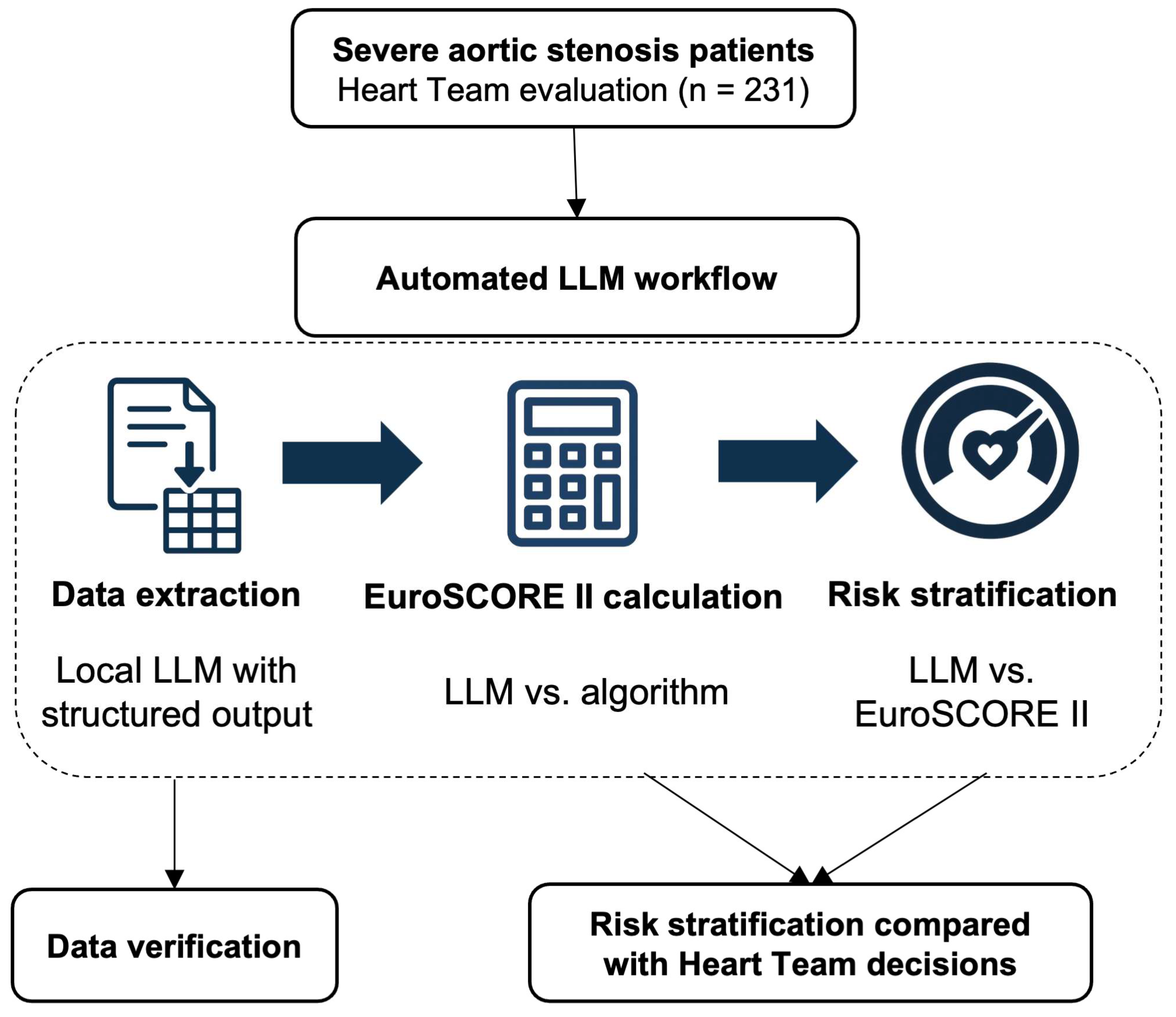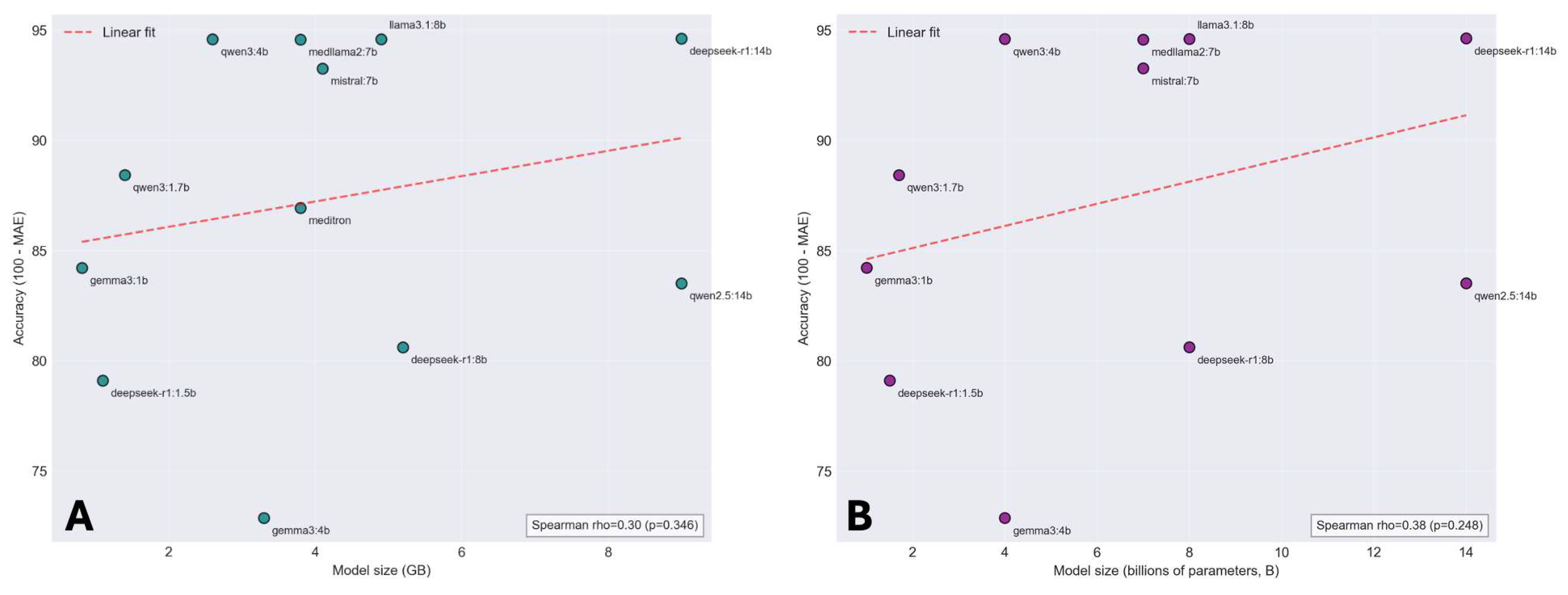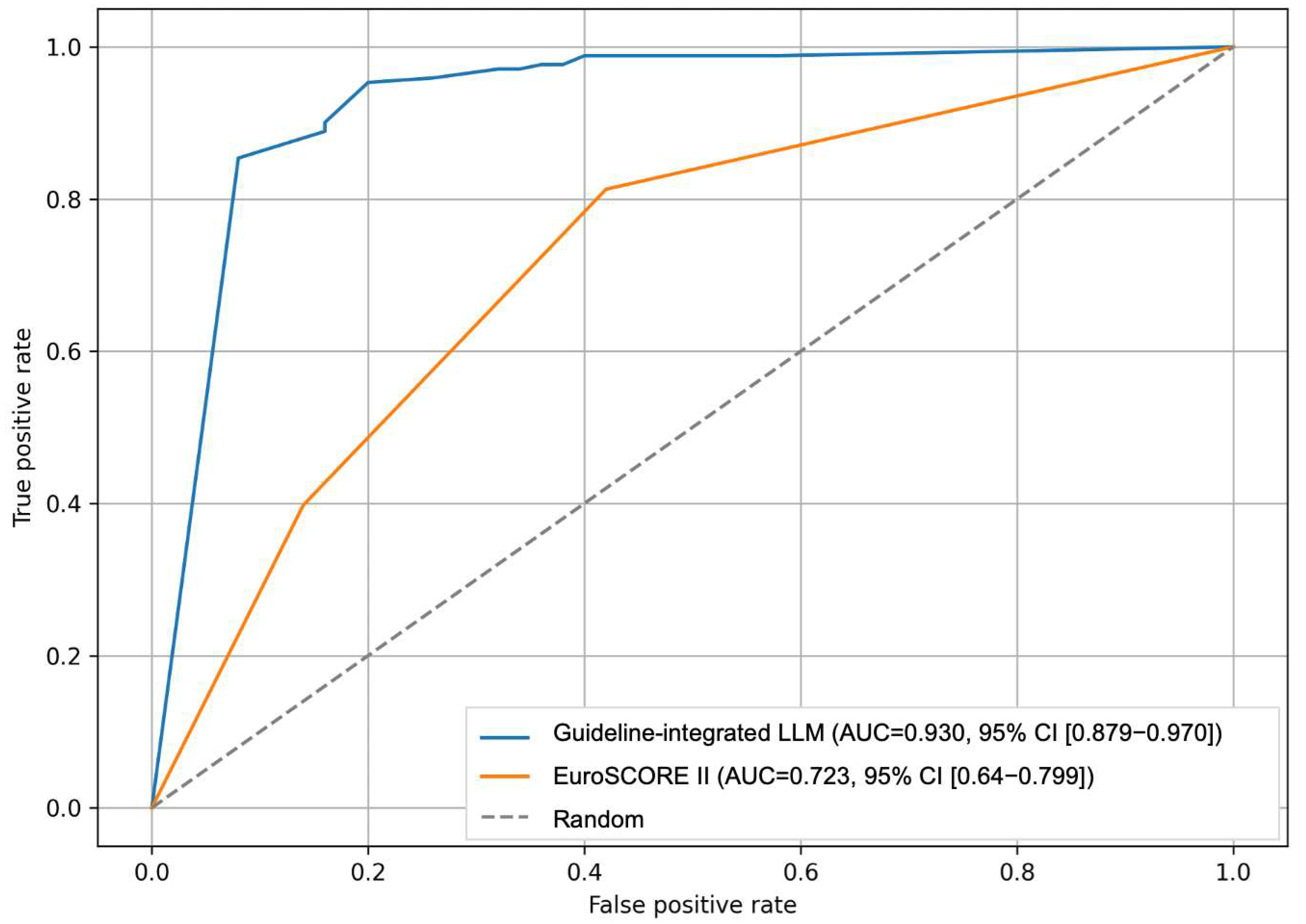AI-Automated Risk Operative Stratification for Severe Aortic Stenosis: A Proof-of-Concept Study
Abstract
1. Introduction
2. Materials and Methods
2.1. Development of the Automated Clinical Workflow
2.2. Technical Infrastructure and Implementation
2.3. Statistical Analysis
3. Results
3.1. Study Population Characteristics
3.2. Performance of the Automated Workflow
3.3. EuroSCORE II Calculation
3.4. Risk Stratification Performance
4. Discussion
5. Limitations
6. Conclusions
Supplementary Materials
Author Contributions
Funding
Institutional Review Board Statement
Informed Consent Statement
Data Availability Statement
Conflicts of Interest
References
- Vahanian, A.; Beyersdorf, F.; Praz, F.; Milojevic, M.; Baldus, S.; Bauersachs, J.; Capodanno, D.; Conradi, L.; De Bonis, M.; De Paulis, R.; et al. 2021 ESC/EACTS guidelines for the management of valvular heart disease: Developed by the task force for the management of valvular heart disease of the European society of cardiology (ESC) and the European association for cardio-thoracic surgery (EACTS). Eur. Heart J. 2022, 43, 561–632. [Google Scholar] [CrossRef] [PubMed]
- Praz, F.; Borger, M.A.; Lanz, J.; Marin-Cuartas, M.; Abreu, A.; Adamo, M.; Ajmone Marsan, N.; Barili, F.; Bonaros, N.; Cosyns, B.; et al. 2025 ESC/EACTS guidelines for the management of valvular heart disease. Eur. Heart J. 2025, 67, ehaf194. [Google Scholar] [CrossRef]
- Chen, S.; Pop, A.; Dasi, L.P.; George, I. Lifetime management for aortic stenosis: Strategy and decision-making in the current era. Ann. Thorac. Surg. 2025, 119, 296–307. [Google Scholar] [CrossRef]
- Windecker, S.; Okuno, T.; Unbehaun, A.; Mack, M.; Kapadia, S.; Falk, V. Which patients with aortic stenosis should be referred to surgery rather than transcatheter aortic valve implantation? Eur. Heart J. 2022, 43, 2729–2750. [Google Scholar] [CrossRef]
- Nashef, S.A.M.; Roques, F.; Sharples, L.D.; Nilsson, J.; Smith, C.; Goldstone, A.R.; Lockowandt, U. EuroSCORE II. Eur. J. Cardio-Thorac. Surg. 2012, 41, 734–745. [Google Scholar] [CrossRef] [PubMed]
- Mastroiacovo, G.; Bonomi, A.; Ludergnani, M.; Franchi, M.; Maragna, R.; Pirola, S.; Baggiano, A.; Caglio, A.; Pontone, G.; Polvani, G.; et al. Is EuroSCORE II still a reliable predictor for cardiac surgery mortality in 2022? A retrospective study. Eur. J. Cardio-Thorac. Surg. 2023, 64, ezad294. [Google Scholar] [CrossRef]
- Liu, P.; Shih, H.; Kang, P.; Pan, J.-Y.; Wu, T.-H.; Wu, C.-J. Performance of the EuroSCORE II model in predicting short-term mortality of general cardiac surgery: A single-center study in Taiwan. Acta Cardiol. Sin. 2022, 38, 495–503. [Google Scholar] [CrossRef] [PubMed]
- Lebreton, G.; Merle, S.; Inamo, J.; Hennequin, J.-L.; Sanchez, B.; Rilos, Z.; Roques, F. Limitations in the inter-observer reliability of EuroSCORE: What should change in EuroSCORE II? Eur. J. Cardio-Thorac. Surg. 2011, 40, 1304–1308. [Google Scholar] [CrossRef]
- Ad, N.; Holmes, S.D.; Patel, J.; Pritchard, G.; Shuman, D.J.; Halpin, L. Comparison of EuroSCORE II, original EuroSCORE, and the society of thoracic surgeons risk score in cardiac surgery patients. Ann. Thorac. Surg. 2016, 102, 573–579. [Google Scholar] [CrossRef]
- Armoundas, A.A.; Narayan, S.M.; Arnett, D.K.; Spector-Bagdady, K.; Bennett, D.A.; Celi, L.A.; Friedman, P.A.; Gollob, M.H.; Hall, J.L.; Kwitek, A.E.; et al. Use of artificial intelligence in improving outcomes in heart disease: A scientific statement from the American heart association. Circulation 2024, 149, e1028–e1050. [Google Scholar] [CrossRef]
- Kung, T.H.; Cheatham, M.; Medenilla, A.; Sillos, C.; De Leon, L.; Elepaño, C.; Madriaga, M.; Aggabao, R.; Diaz-Candido, G.; Maningo, J.; et al. Performance of ChatGPT on USMLE: Potential for AI-assisted medical education using large language models. PLoS Digit. Health 2023, 2, e0000198. [Google Scholar] [CrossRef]
- Gala, D.; Makaryus, A.N. The utility of language models in cardiology: A narrative review of the benefits and concerns of ChatGPT-4. Int. J. Environ. Res. Public Health 2023, 20, 6438. [Google Scholar] [CrossRef]
- Topol, E.J. High-performance medicine: The convergence of human and artificial intelligence. Nat. Med. 2019, 25, 44–56. [Google Scholar] [CrossRef]
- Johnson, K.W.; Torres Soto, J.; Glicksberg, B.S.; Shameer, K.; Miotto, R.; Ali, M.; Ashley, E.; Dudley, J.T. Artificial intelligence in cardiology. J. Am. Coll. Cardiol. 2018, 71, 2668–2679. [Google Scholar] [CrossRef] [PubMed]
- Kim, S.H.; Schramm, S.; Adams, L.C.; Braren, R.; Bressem, K.K.; Keicher, M.; Platzek, P.-S.; Paprottka, K.J.; Zimmer, C.; Hedderich, D.M.; et al. Benchmarking the diagnostic performance of open source LLMs in 1933 eurorad case reports. npj Digit. Med. 2025, 8, 97. [Google Scholar] [CrossRef] [PubMed]
- Shojaei, S.; Mousavi, A.; Kazemian, S.; Armani, S.; Maleki, S.; Fallahtafti, P.; Arashlow, F.T.; Daryabari, Y.; Naderian, M.; Alkhouli, M.; et al. Artificial intelligence in risk stratification and outcome prediction for transcatheter aortic valve replacement: A systematic review and meta-analysis. J. Pers. Med. 2025, 15, 302. [Google Scholar] [CrossRef]
- Garin, D.; Cook, S.; Ferry, C.; Bennar, W.; Togni, M.; Meier, P.; Wenaweser, P.; Puricel, S.; Arroyo, D. Improving large language models accuracy for aortic stenosis treatment via heart team simulation: A prompt design analysis. Eur. Heart J. Digit. Health 2025, 6, 665–674. [Google Scholar] [CrossRef]
- Zayas-Cabán, T.; Okubo, T.H.; Posnack, S. Priorities to accelerate workflow automation in health care. J. Am. Med. Inform. Assoc. 2023, 30, 195–201. [Google Scholar] [CrossRef]
- Pereira, M.; Concheiro-Moscoso, P.; López-Álvarez, A.; Baños, G.; Pazos, A.; Pereira, J. Applicability of clinical decision support in management among patients undergoing cardiac surgery in intensive care unit: A systematic review. Appl. Sci. 2021, 11, 2880. [Google Scholar] [CrossRef]
- Putty, C. Streamlining Clinical Workflows: How Automation Enhances Healthcare Productivity. Available online: https://www.thoughtful.ai/blog/streamlining-clinical-workflows-how-automation-enhances-healthcare-productivity (accessed on 19 September 2025).
- Liu, W.; Laranjo, L.; Klimis, H.; Chiang, J.; Yue, J.; Marschner, S.; Quiroz, J.C.; Jorm, L.; Chow, C.K. Machine-learning versus traditional approaches for atherosclerotic cardiovascular risk prognostication in primary prevention cohorts: A systematic review and meta-analysis. Eur. Heart J. Qual. Care Clin. Outcomes 2023, 9, 310–322. [Google Scholar] [CrossRef] [PubMed]
- Krittanawong, C.; Virk, H.U.H.; Bangalore, S.; Wang, Z.; Johnson, K.W.; Pinotti, R.; Zhang, H.; Kaplin, S.; Narasimhan, B.; Kitai, T.; et al. Machine learning prediction in cardiovascular diseases: A meta-analysis. Sci. Rep. 2020, 10, 16507. [Google Scholar] [CrossRef]
- Ma, H.; Lin, S.; Li, X.; Wang, Y.; Yang, W.; Dou, K.; Liu, S.; Zheng, Z.; Modified Heart Team Protocol Study Group. The modified heart team protocol facilitated the revascularization decision-making quality in complex coronary artery disease. Interdiscip. Cardiovasc. Thorac. Surg. 2025, 40, ivaf023. [Google Scholar] [CrossRef]
- Groenhof, T.K.J.; Asselbergs, F.W.; Groenwold, R.H.; Grobbee, D.E.; Visseren, F.L.; Bots, M.L.; UCC-SMART Study Group. The effect of computerized decision support systems on cardiovascular risk factors: A systematic review and meta-analysis. BMC Med. Inform. Decis. Mak. 2019, 19, 108. [Google Scholar] [CrossRef] [PubMed]
- Kwong, J.C.C.; Wang, S.C.Y.; Nickel, G.C.; Cacciamani, G.E.; Kvedar, J.C. The long but necessary road to responsible use of large language models in healthcare research. npj Digit. Med. 2024, 7, 177. [Google Scholar] [CrossRef] [PubMed]
- Singhal, K.; Azizi, S.; Tu, T.; Mahdavi, S.S.; Wei, J.; Chung, H.W.; Scales, N.; Tanwani, A.; Cole-Lewis, H.; Pfohl, S.; et al. Large language models encode clinical knowledge. Nature 2023, 620, 172–180. [Google Scholar] [CrossRef] [PubMed]
- Kim, Y.; Jeong, H.; Chen, S.; Li, S.S.; Lu, M.; Alhamoud, K.; Mun, J.; Grau, C.; Jung, M.; Gameiro, R.; et al. Medical hallucinations in foundation models and their impact on healthcare. medRxiv 2025. [Google Scholar] [CrossRef]
- Asgari, E.; Montaña-Brown, N.; Dubois, M.; Khalil, S.; Balloch, J.; Au Yeung, J.; Pimenta, D. A framework to assess clinical safety and hallucination rates of LLMs for medical text summarisation. npj Digit. Med. 2025, 8, 274. [Google Scholar] [CrossRef]
- Ohde, J.W.; Rost, L.M.; Overgaard, J.D. The burden of reviewing LLM-generated content. NEJM AI 2025, 2, AIp2400979. [Google Scholar] [CrossRef]
- Wang, Y.; Liu, C.; Hu, W.; Luo, L.; Shi, D.; Zhang, J.; Yin, Q.; Zhang, L.; Han, X.; He, M. Economic evaluation for medical artificial intelligence: Accuracy vs. Cost-effectiveness in a diabetic retinopathy screening case. npj Digit. Med. 2024, 7, 43. [Google Scholar] [CrossRef]



| Characteristic | Value |
|---|---|
| Demographic | |
| Female sex—no./total no. (%) | 135/231 (58.4) |
| Age—yr | 79.5 ± 7.7 |
| Medical history | |
| Mean body mass index—kg·m2 † | 27.4 ± 5.4 |
| Mean EuroSCORE II ‡ | 4.35 ± 3.15 |
| Mean STS § | 2.8 ± 1.62 |
| New York Heart Association class—no. (%) | |
| I | 54 (23.4) |
| II | 105 (45.4) |
| III | 51 (22.5) |
| IV | 19 (8.2) |
| Syncope linked to aortic stenosis—no. (%) | 7 (3.0) |
| Previous coronary artery disease—no. (%) | 144 (62.3) |
| Previous acute coronary syndrome—no. (%) | 23 (9.9) |
| Previous cardiac surgery—no. (%) | |
| Coronary artery bypass surgery (CABG) | 19 (8.4) |
| Aortic valve surgery | 8 (3.8) |
| CABG and aortic valve surgery | 3 (1.5) |
| Baseline echocardiogram | |
| Left ventricular ejection fraction—% | 57.8 ± 11.5 |
| Aortic valve surface—cm2 | 0.79 ± 0.24 |
| Aortic valve regurgitation—no. (%) | |
| Moderate | 26 (11.5) |
| Severe | 6 (2.6) |
| Aortic valve gradient—mmHg | 36.9 ± 11.2 |
| Mitral valve regurgitation—no. (%) | |
| Moderate | 33 (14.2) |
| Severe | 3 (1.3) |
| Tricuspid valve regurgitation—no. (%) | |
| Moderate | 15 (6.4) |
| Severe | 4 (1.7) |
| Systolic pulmonary artery pressure—mmHg | 44.2 ± 14.1 |
| Baseline electrocardiogram—no. (%) | |
| Atrioventricular block | 30 (12.9) |
| Right bundle branch block | 18 (7.7) |
| Left bundle branch block | 28 (12.1) |
| Atrial fibrillation | 56 (24.4) |
| Cardiovascular disease risk factors—no. (%) | |
| Diabetes | 65 (28.1) |
| Requiring insulin | 17 (7.4) |
| Hypertension | 170 (73.6) |
| Dyslipidemia | 110 (47.6) |
| Current or previous smoking | 39 (16.8) |
| Non-cardiac previous history | |
| Chronic obstructive pulmonary disease—no. (%) | 18 (7.6) |
| Moderate kidney disease—no. (%) | 69 (29.8) |
| Severe kidney disease—no. (%) | 65 (28.8) |
| Creatinine—μmol/L | 97.7 ± 44.5 |
| Creatinine clearance—mL·min−1·1.73·m−2 | 58.1 ± 24.8 |
| Peripheral artery disease—no. (%) | 30 (12.9) |
| Previous vascular surgery—no. (%) | 9 (3.8) |
| Previous stroke or transient ischemic attack—no. (%) | 26 (11.4) |
| Heart Team decision—no. (%) | |
| Transcatheter aortic valve implantation | 168 (72.7) |
| Surgical aortic valve replacement | 50 (21.6) |
| Medical management | 13 (5.6) |
| Workflow Component | Mean Time (Seconds) | Standard Deviation |
|---|---|---|
| Data extraction | 14.3 | 3.0 |
| EuroSCORE II calculation | 8.1 | 2.2 |
| Risk stratification | 9.4 | 2.9 |
| Total workflow | 32.6 | 6.4 |
| Approach | AUC | 95% CI | Sensitivity | Specificity |
|---|---|---|---|---|
| Guideline-integrated LLM without EuroSCORE | 0.93 | 0.87–0.97 | 0.98 | 0.64 |
| Guideline-integrated LLM with EuroSCORE | 0.76 | 0.69–0.83 | 0.88 | 0.64 |
| EuroSCORE-based (non-high risk) | 0.72 | 0.66–0.79 | 0.98 | 0.46 |
| EuroSCORE-based (high risk) | 0.63 | 0.57–0.69 | 0.40 | 0.86 |
Disclaimer/Publisher’s Note: The statements, opinions and data contained in all publications are solely those of the individual author(s) and contributor(s) and not of MDPI and/or the editor(s). MDPI and/or the editor(s) disclaim responsibility for any injury to people or property resulting from any ideas, methods, instructions or products referred to in the content. |
© 2025 by the authors. Licensee MDPI, Basel, Switzerland. This article is an open access article distributed under the terms and conditions of the Creative Commons Attribution (CC BY) license (https://creativecommons.org/licenses/by/4.0/).
Share and Cite
Garin, D.; Arroyo, D.; Skalidis, I.; Di Cicco, P.; Ferry, C.; Bennar, W.; Puricel, S.; Meier, P.; Togni, M.; Cook, S. AI-Automated Risk Operative Stratification for Severe Aortic Stenosis: A Proof-of-Concept Study. J. Clin. Med. 2025, 14, 8304. https://doi.org/10.3390/jcm14238304
Garin D, Arroyo D, Skalidis I, Di Cicco P, Ferry C, Bennar W, Puricel S, Meier P, Togni M, Cook S. AI-Automated Risk Operative Stratification for Severe Aortic Stenosis: A Proof-of-Concept Study. Journal of Clinical Medicine. 2025; 14(23):8304. https://doi.org/10.3390/jcm14238304
Chicago/Turabian StyleGarin, Dorian, Diego Arroyo, Ioannis Skalidis, Philippe Di Cicco, Charlie Ferry, Wesley Bennar, Serban Puricel, Pascal Meier, Mario Togni, and Stéphane Cook. 2025. "AI-Automated Risk Operative Stratification for Severe Aortic Stenosis: A Proof-of-Concept Study" Journal of Clinical Medicine 14, no. 23: 8304. https://doi.org/10.3390/jcm14238304
APA StyleGarin, D., Arroyo, D., Skalidis, I., Di Cicco, P., Ferry, C., Bennar, W., Puricel, S., Meier, P., Togni, M., & Cook, S. (2025). AI-Automated Risk Operative Stratification for Severe Aortic Stenosis: A Proof-of-Concept Study. Journal of Clinical Medicine, 14(23), 8304. https://doi.org/10.3390/jcm14238304






